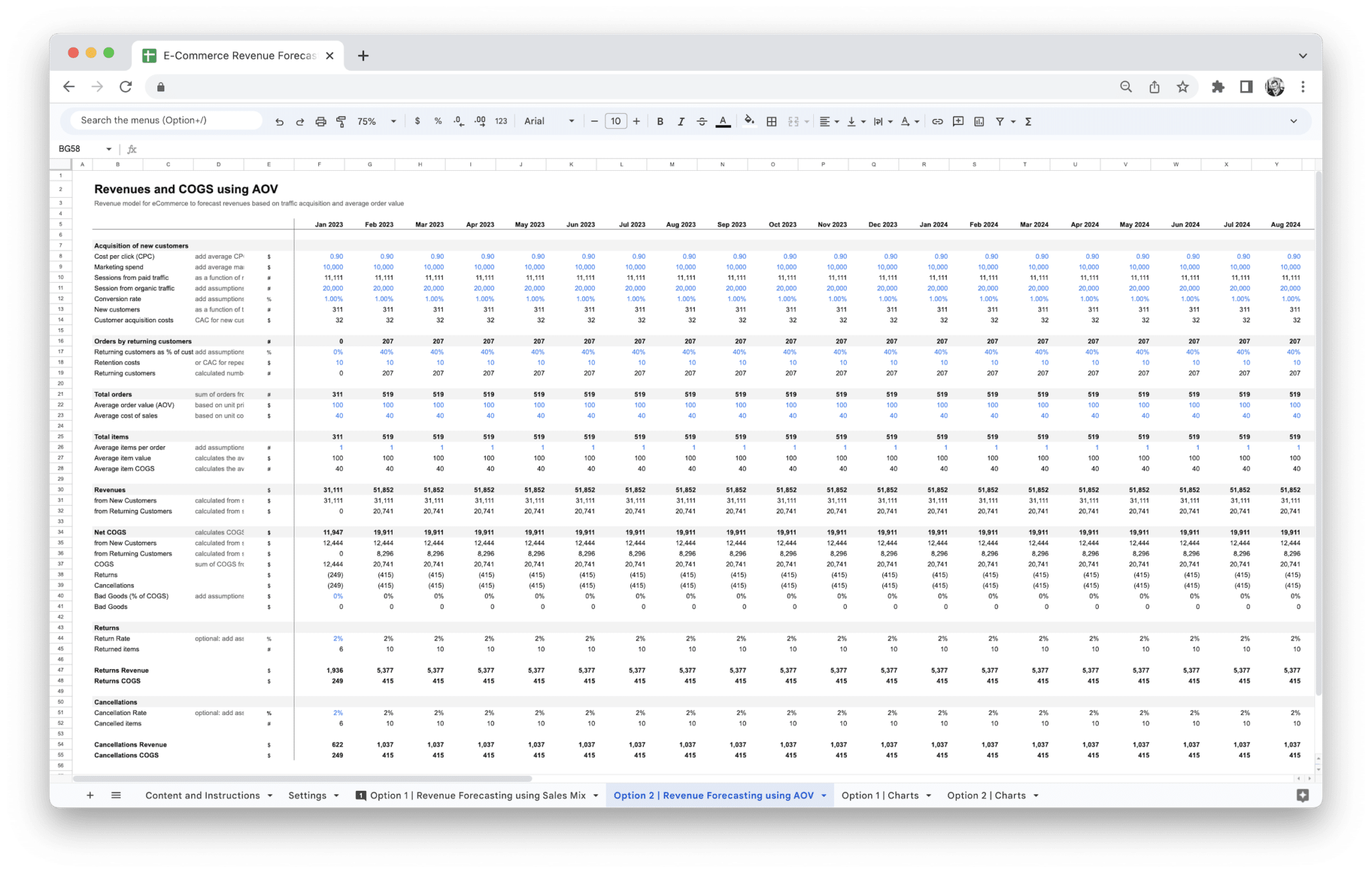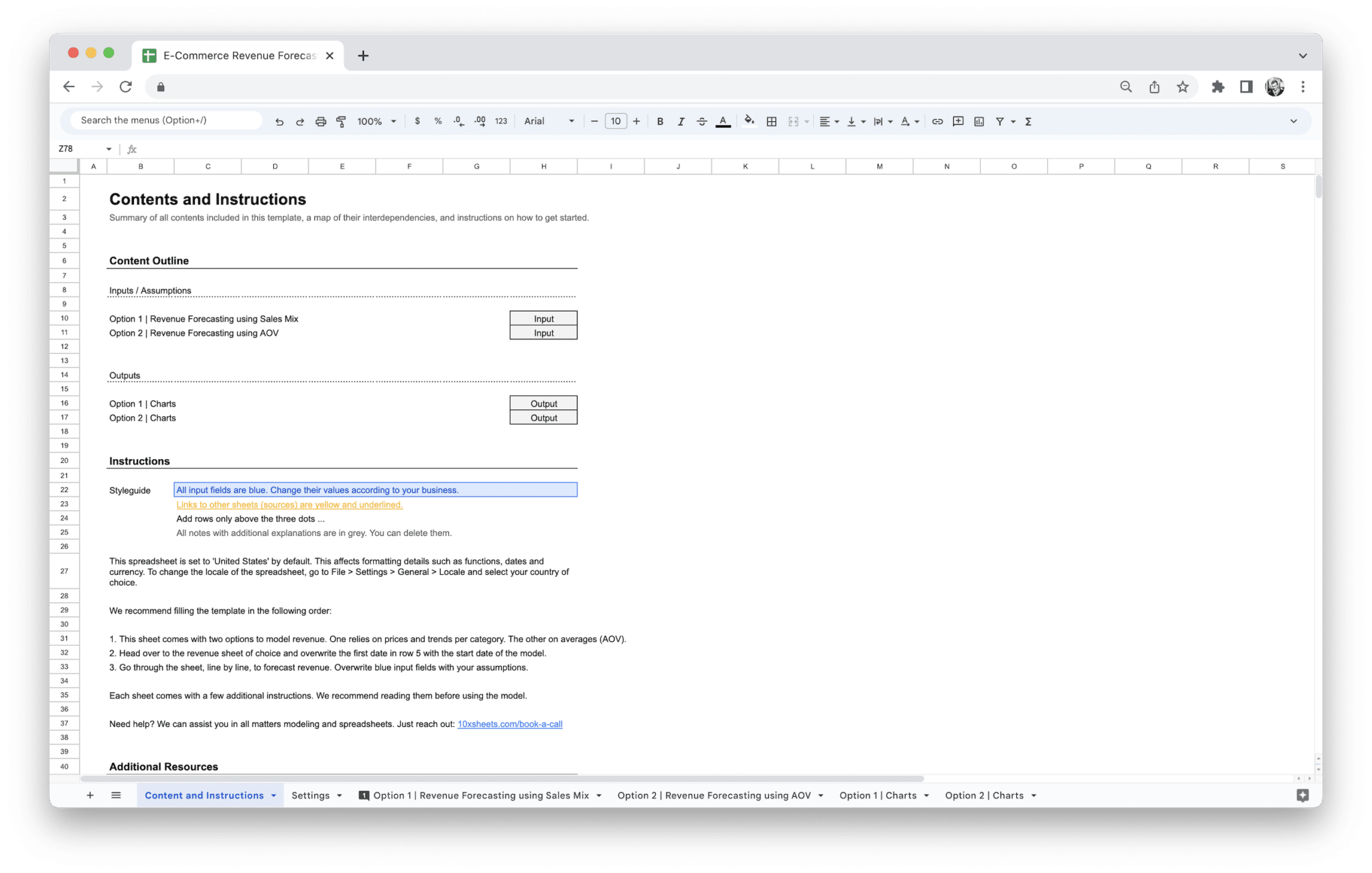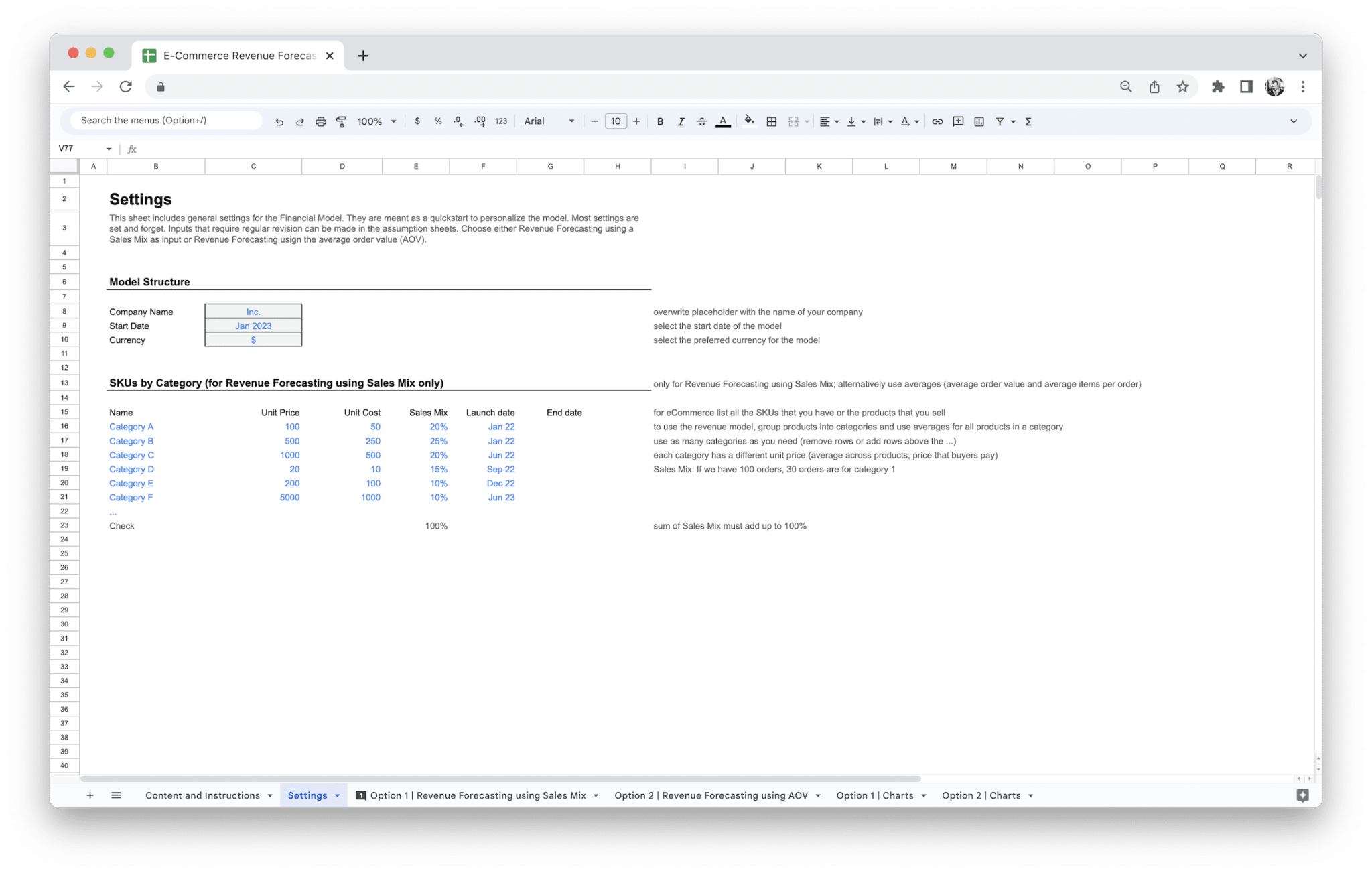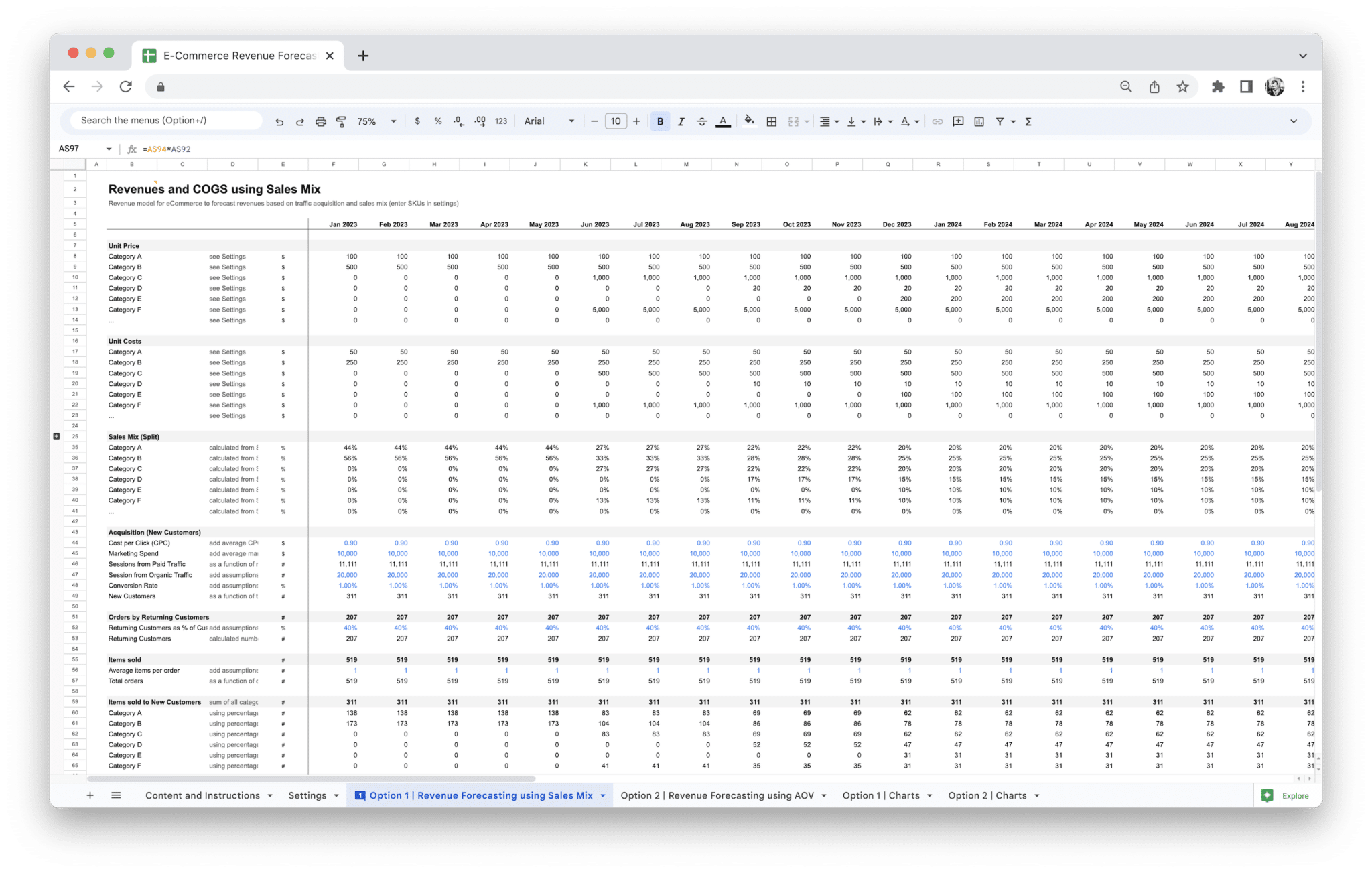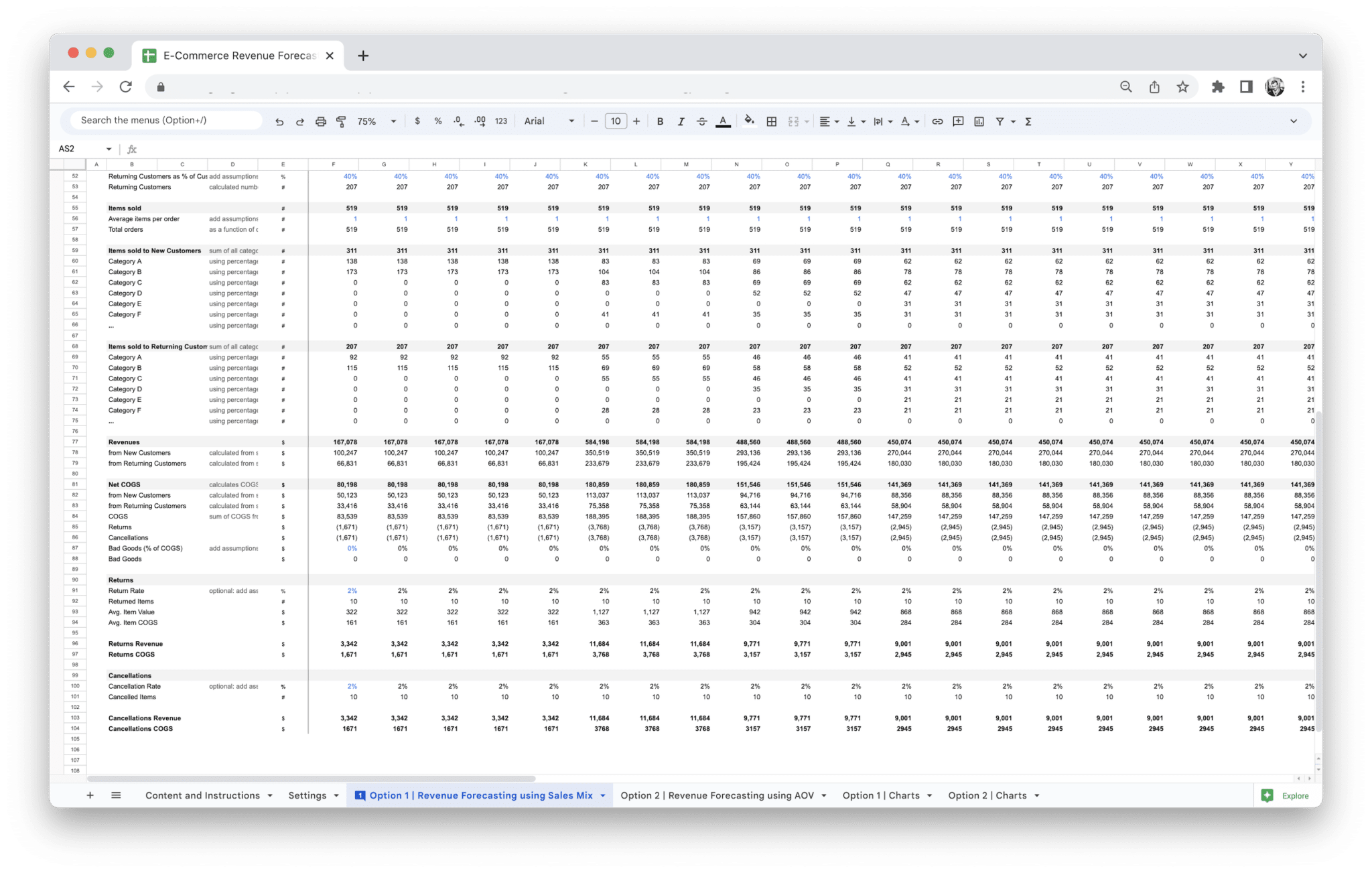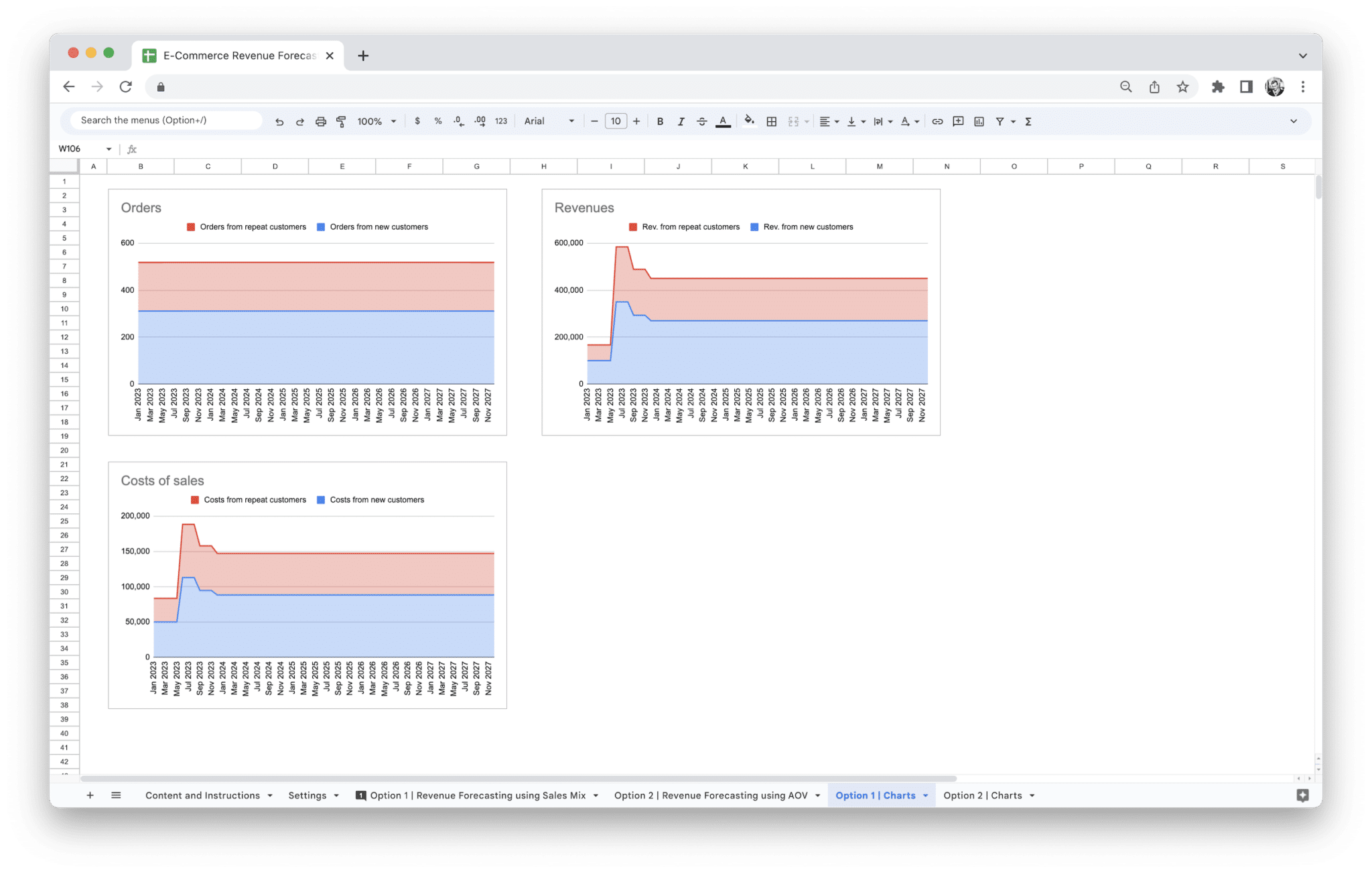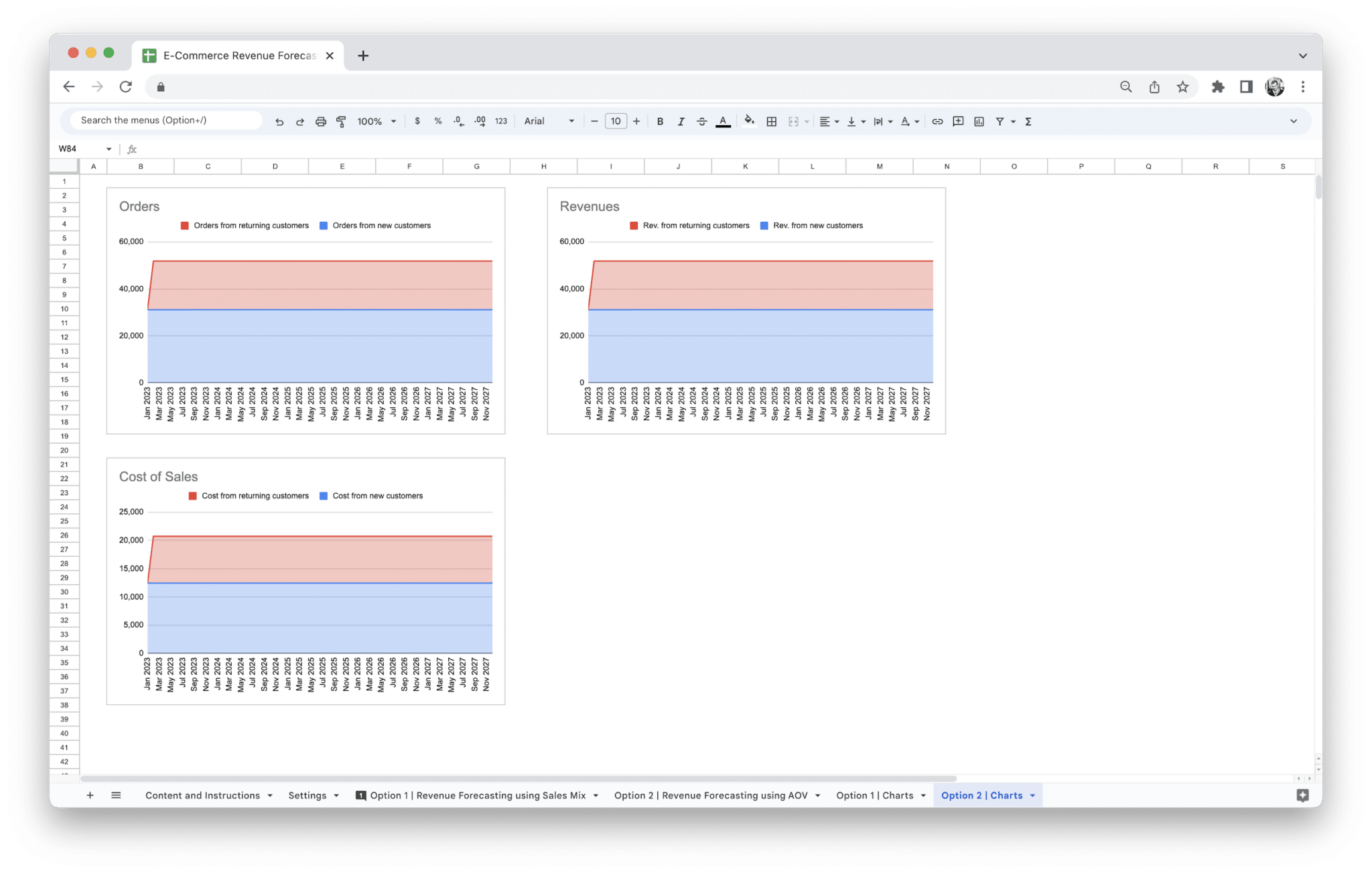E-Commerce Revenue Forecasting Tool
41,18 €
Value added tax is not collected, as small businesses according to §19 (1) UStG.
Choose from two revenue models and visualize your metrics with easy-to-read charts. Plan your operations, make informed decisions, and take control of your e-commerce business’s financial planning to stay ahead of the competition!
Description
Predicting revenue accurately is one of the biggest challenges for e-commerce businesses. Without clear insights into future sales, managing inventory, budgeting, and allocating resources effectively becomes a guessing game. As your business grows, the complexity of forecasting only increases, making it harder to stay ahead of demand and avoid costly mistakes.
Our E-Commerce Revenue Forecasting Tool Template solves this problem by giving you a straightforward and powerful way to forecast your revenue with accuracy. This template allows you to input historical data, adjust for seasonality, and factor in marketing efforts, giving you a complete picture of your financial future. With built-in features like customizable revenue streams, automatic calculations, and scenario analysis, you can make informed, data-driven decisions that optimize your inventory, improve cash flow management, and ultimately boost profitability. Say goodbye to uncertainty and let our tool take the guesswork out of your forecasting process.
E-commerce revenue forecasting is the practice of predicting the future revenue of an online business based on historical data, current trends, and external factors. The goal is to estimate how much money a business will generate over a specific period, typically by analyzing patterns from past sales, seasonality, and changes in market conditions. Revenue forecasting in the e-commerce space is essential for making informed business decisions, from planning inventory to setting marketing budgets and evaluating profitability.
Accurate forecasting helps e-commerce businesses plan better, reduce risks, and optimize their operations. Given the fast-moving nature of online retail, having a clear picture of future revenue is critical to ensuring that resources are appropriately allocated, products are stocked in the right amounts, and strategies are executed effectively. Whether you’re a small business or a large e-commerce giant, a good forecast helps you predict trends, manage cash flow, and set realistic growth targets.
Importance of Accurate Revenue Forecasting in E-Commerce
- Improves Business Planning: Accurately forecasting revenue helps businesses plan for future expenses, inventory needs, and operational requirements.
- Optimizes Cash Flow Management: Knowing when revenue will come in allows businesses to make smarter decisions about spending and saving, ensuring they don’t run into cash shortages.
- Enhances Inventory Management: Accurate forecasts help businesses avoid overstocking or understocking products by predicting demand and adjusting inventory levels accordingly.
- Strengthens Budget Allocation: When you can predict revenue with confidence, it’s easier to allocate resources efficiently, whether for marketing campaigns, hiring, or expanding operations.
- Supports Data-Driven Decisions: Accurate forecasts provide solid data that businesses can rely on when making decisions about product launches, sales strategies, and market expansion.
- Reduces Risks: By anticipating fluctuations in revenue due to seasonality or other factors, businesses can proactively adjust their strategies and minimize potential financial setbacks.
- Boosts Investor Confidence: For businesses seeking investment, providing reliable revenue forecasts helps show potential for growth and financial stability, which is crucial for securing funding.
How a Forecasting Tool Template Can Simplify the Process
Forecasting revenue manually can be time-consuming and prone to error. A tool template simplifies the process by automating calculations, organizing data, and making the forecasting process more efficient. Here’s how a forecasting tool template can help:
- Automates Complex Calculations: Instead of manually inputting complex formulas and performing time-consuming calculations, a template does it for you, saving time and reducing errors.
- Centralizes Data: A good forecasting tool template consolidates all your revenue-related data in one place, making it easier to analyze and track performance.
- Offers Customization: Most templates allow you to adjust variables based on your business model, enabling you to tailor the tool to fit your specific needs.
- Provides Scenario Analysis: Many forecasting tools include the ability to model different scenarios (e.g., best-case, worst-case) so you can assess potential outcomes under various conditions.
- Integrates with Existing Systems: Some templates can be integrated with your e-commerce platform, marketing tools, and CRM systems, allowing seamless data flow and more accurate forecasts.
- Reduces Human Error: By automating key processes, a forecasting tool template helps eliminate human error that often comes with manual calculations or data entry.
- Improves Decision-Making: With a clearer understanding of your revenue trajectory, you’ll be able to make better, more informed decisions that align with your business goals.
What is an E-Commerce Revenue Forecasting Tool?
An E-Commerce Revenue Forecasting Tool is a software or template designed to predict the future revenue of an online business. By analyzing historical data, trends, and other relevant variables, these tools provide businesses with a detailed outlook on how much they are likely to earn over a specific time period. These tools use algorithms and models to generate accurate forecasts that can inform decisions related to inventory, marketing strategies, and overall business planning.
At its core, a forecasting tool uses past sales data to identify patterns, factors in seasonality and other external influences, and then generates projections about future revenue. The tool helps businesses anticipate potential fluctuations in demand, optimize resources, and ensure financial stability by predicting cash flow and operational needs.
Key Components of an E-Commerce Revenue Forecasting Tool
- Historical Sales Data: Past sales data is the foundation of any revenue forecast. The tool uses this data to spot trends, calculate growth rates, and predict future performance.
- Revenue Streams: The tool allows businesses to input different types of revenue streams (e.g., product sales, subscription fees, affiliate commissions), helping create a comprehensive view of total income.
- Sales Channels: Many e-commerce businesses sell across multiple platforms (e.g., their own website, Amazon, eBay). A good forecasting tool allows businesses to track revenue from each channel separately.
- Seasonality Adjustments: The tool should account for seasonal variations in sales, such as spikes during holidays or drops during the off-season, providing more accurate predictions.
- Marketing and Sales Influences: It should include fields to input the impact of marketing campaigns or promotions, allowing businesses to assess how these efforts will influence revenue.
- Expense Tracking: While forecasting revenue is important, tracking expenses is equally critical. A tool should allow businesses to input operating costs to better understand profitability.
- Growth Projections: A forecasting tool can help project future growth based on historical data, market trends, or business plans like new product launches or expanded marketing efforts.
- Scenario Planning: The ability to model different scenarios (e.g., increased marketing spend, higher product prices) allows businesses to test the effects of various changes on future revenue.
Benefits of Using a Forecasting Tool in the E-Commerce Space
- Improved Cash Flow Management: By predicting when revenue will be generated, businesses can better manage cash flow, ensuring there’s enough to cover expenses and avoid liquidity issues.
- Better Inventory Planning: Accurate forecasts help businesses plan inventory more effectively by predicting which products will sell well and when.
- Optimized Resource Allocation: With a clear picture of future revenue, businesses can allocate resources more efficiently, ensuring funds are directed toward high-priority areas such as marketing, staffing, or inventory.
- Data-Driven Decision Making: Forecasting tools provide reliable data to inform decisions, removing the guesswork from critical business operations like pricing, staffing, and promotions.
- Scalability: As businesses grow, forecasting tools can scale with them, handling more complex data sets, integrating with other systems, and providing more detailed insights.
- Minimized Risk: By predicting revenue fluctuations, businesses can plan for slow periods, take advantage of busy seasons, and reduce the financial risks associated with unforeseen market changes.
- Competitive Advantage: Businesses that use accurate forecasts can be more agile and responsive to market trends, giving them an edge over competitors who are less prepared.
- Increased Profitability: Better forecasts lead to smarter decisions, such as optimizing product pricing or marketing spend, which ultimately drives profitability and growth.
An effective E-Commerce Revenue Forecasting Tool Template is designed to make predicting your business’s future revenue as accurate and seamless as possible. The best tools offer a variety of features that enable you to customize inputs, calculate projections, integrate different data sources, and even test various forecasting scenarios. These features ensure that you can get the most out of your forecasting efforts, whether you’re running a small online store or managing a large, multi-channel e-commerce operation.
Customizable Input Fields for Different Revenue Sources
Every e-commerce business is unique, with different revenue streams and operational structures. That’s why one-size-fits-all templates often fall short. A good forecasting tool should provide you with the ability to customize input fields for each of your specific revenue sources.
Whether you’re selling physical products, digital downloads, services, or subscriptions, being able to track each revenue stream separately gives you better insights into where your money is coming from and how to optimize it. For example, if you have multiple product categories (e.g., electronics, clothing, accessories), you should be able to break down your forecast by each category, ensuring that you don’t miss out on potential growth opportunities. Similarly, if you rely on recurring revenue models like subscriptions, you can adjust for renewal rates, churn, and customer acquisition costs specific to that model.
Having customizable fields also allows you to plug in different variables that may affect your sales, such as special discounts, seasonal offers, or high-performing promotions. Customization ensures that you can adapt the template to your business’s exact needs, making your forecasts more precise and actionable.
Automatic Calculations Based on Historical Data
The core of any solid forecasting tool is the ability to automatically calculate projections based on historical data. Without historical sales data, any prediction would be just a shot in the dark. By using your past performance as the foundation, the tool can provide more reliable and realistic forecasts.
For instance, the tool can analyze data from previous months or years to identify trends and patterns in your sales. This is particularly useful in understanding the impact of seasonality, marketing campaigns, or price fluctuations. Automatic calculations mean you don’t have to manually input complex formulas or spend time calculating averages or growth rates. The tool will do the heavy lifting for you, saving you time and reducing human error.
Moreover, advanced forecasting tools can also account for growth trends, adjusting future projections based on the trajectory of your sales. If your business has been growing consistently by 10% each month, for example, the tool can project this same rate of growth moving forward, while also factoring in potential variations like product launches or market shifts.
Automatic calculations help streamline your forecasting process, offering you insights into potential future revenue without having to dive deep into spreadsheets. The ability to generate quick, reliable figures helps you make data-driven decisions with confidence, whether it’s planning for a new product launch or preparing for a slow season.
Integration with Sales, Marketing, and Inventory Data
One of the biggest advantages of using a forecasting tool is the ability to integrate various data sources into one comprehensive view of your business’s financial future. In order to make accurate projections, the tool should be able to pull data from your sales, marketing, and inventory systems.
Sales data is the most obvious source. But revenue forecasting isn’t just about looking at how much you sold last month or last year. By integrating sales data, you can track performance across multiple platforms (e.g., your online store, Amazon, eBay) and ensure that you’re capturing all of your income sources. This integration helps avoid the problem of missing out on sales from certain channels, providing you with a holistic view of your revenue.
Marketing data is just as crucial. E-commerce businesses are often heavily reliant on paid ads, SEO, email marketing, and social media campaigns to drive sales. A forecasting tool that integrates marketing data can help you see how your campaigns are influencing your revenue. For example, if you know that a particular Facebook ad campaign led to a 30% increase in sales last month, the tool can incorporate this into future revenue predictions. By understanding the ROI of each campaign, you can adjust your forecasts based on upcoming marketing strategies.
Inventory data also plays a critical role in forecasting. If your inventory levels are running low on a popular product, it could significantly affect your revenue forecast. Conversely, if you’re overstocked on an item that’s not selling well, it may lead to wasted resources and missed opportunities. Integrating inventory data ensures that you can account for potential stock-outs or overstocking, both of which can directly impact your revenue predictions.
When all this data is integrated, you get a clearer picture of how each element of your business contributes to overall revenue. It allows you to forecast more accurately and make decisions based on a comprehensive, data-driven understanding of your operations.
Scenario Analysis for Various Forecasting Outcomes
One of the standout features of a powerful e-commerce revenue forecasting tool is the ability to run scenario analyses. In real life, things rarely go exactly as planned, so being able to test different scenarios is invaluable for planning. A scenario analysis allows you to model different outcomes based on changes to key variables, helping you prepare for uncertainty and make informed decisions.
For example, you could set up a scenario where you increase your marketing budget by 20%. The tool can then model how this change might impact your sales, based on historical data and predicted trends. Alternatively, you can test the impact of a price change or even a disruption in your supply chain. What would happen if a supplier raised prices or if shipping delays affected your ability to fulfill orders on time? By inputting these scenarios, the tool can help you understand how various factors might influence your future revenue.
Scenario analysis also helps you make contingency plans. What if your business sees unexpected growth? How will you scale your operations to handle the increased demand? What if your business hits a slow season earlier than expected? Scenario planning helps you prepare for both the best- and worst-case scenarios so that you’re ready to adapt to changes in your business environment.
This flexibility is particularly important in the fast-paced world of e-commerce, where market conditions, consumer behavior, and external factors like economic downturns or trade policies can drastically shift. A tool that lets you test various forecasting scenarios enables you to create more robust financial strategies, reducing the risks that come with uncertainty.
The ability to conduct scenario analysis doesn’t just help you predict what’s likely to happen—it empowers you to plan for multiple outcomes, making your business more agile and capable of responding to change with confidence.
The key features of an E-Commerce Revenue Forecasting Tool Template are designed to make your revenue predictions as accurate, detailed, and adaptable as possible. By customizing input fields, automatically calculating projections based on historical data, integrating multiple data sources, and testing different forecasting scenarios, you can gain a clearer, more reliable view of your business’s financial future. This will ultimately help you make better decisions, optimize your operations, and plan for sustained growth.
Accurate revenue forecasting is essential to running a successful e-commerce business. The competitive landscape is always evolving, and predicting future revenue with precision helps you stay ahead of the curve. By accurately forecasting your revenue, you can make smarter decisions, optimize operations, and ensure long-term business sustainability. Whether you’re a small startup or a large-scale operation, forecasting allows you to anticipate challenges and opportunities, allowing you to adapt quickly and efficiently.
Optimizing Inventory and Supply Chain Management
Inventory management is one of the most critical aspects of running an e-commerce business, and revenue forecasting plays a pivotal role in getting it right. Without accurate forecasts, you risk either overstocking or understocking, both of which have significant consequences for your business.
Overstocking ties up valuable capital that could be better invested elsewhere. Having excess inventory on hand also increases the risk of obsolescence or damaged goods, especially if you’re selling seasonal products or goods with a limited shelf life. For instance, if your forecast predicts high demand for a product but you end up with a surplus, you’re left with unsold stock that doesn’t generate revenue.
On the other hand, understocking can be even more damaging. Running out of stock during peak demand periods—such as during holidays or promotions—can lead to missed sales, frustrated customers, and lost revenue. Imagine a situation where your most popular product sells out, and customers are forced to wait for weeks before it’s restocked. Not only do you lose sales, but you also risk damaging your brand’s reputation and losing customer loyalty.
Accurate revenue forecasting helps you strike the right balance by predicting the demand for products at different times of the year. It allows you to plan ahead, ensuring that you have enough stock to meet anticipated demand while avoiding unnecessary overstocking. By factoring in variables such as seasonality, promotions, and historical sales trends, you can better align your inventory levels with actual market conditions, ultimately leading to better inventory turnover and fewer stockouts or overstocks.
Budgeting and Resource Allocation
Effective budgeting and resource allocation are the backbone of any successful business, and e-commerce is no different. Without a clear idea of your expected revenue, it’s impossible to allocate resources wisely. Whether it’s investing in marketing, expanding your product offerings, or hiring more staff, revenue forecasting allows you to make data-driven decisions about where to spend and where to save.
Accurate revenue predictions give you the visibility you need to plan for future expenses. For example, if you anticipate higher revenue during the holiday season, you may choose to increase your marketing budget, hire seasonal staff, or stock up on inventory. Conversely, if a slow period is coming, you can reduce expenses and focus on cost-saving measures. By accurately forecasting revenue, you can avoid overspending during lean months or underspending when you need to capitalize on growth.
Additionally, forecasting helps you identify areas where you may be overspending. For instance, if your revenue is coming in lower than expected but you’re still spending heavily on marketing campaigns, it’s important to reassess your strategy. By forecasting future revenue, you can better manage cash flow and ensure that you’re not investing more than what your business can sustain.
The ability to allocate resources efficiently based on accurate forecasts can make the difference between thriving and struggling. Smart budgeting ensures that you have the resources available when you need them most, and allows you to maximize your ROI on every investment you make.
Identifying Trends and Growth Opportunities
Revenue forecasting isn’t just about predicting how much money you’ll make—it’s also about identifying trends and growth opportunities before they become apparent to the competition. By analyzing historical sales data and factoring in variables like market trends, customer behavior, and seasonal shifts, you can uncover patterns that will allow you to make informed, proactive decisions.
For instance, you might notice that a specific product category has been experiencing steady growth over the past few months. Accurate forecasting can help you identify this trend early, enabling you to increase stock levels and tailor your marketing efforts toward this growing segment. Alternatively, you might identify a declining trend in certain products, giving you the opportunity to discontinue them before they become a drain on your resources.
By forecasting revenue, you gain the ability to spot emerging market trends and shifts in consumer preferences. These insights can help you adjust your product mix, marketing campaigns, and sales strategies to capitalize on new opportunities. If a new demographic group starts showing interest in your products, you can adjust your messaging to cater to them, ensuring that your business stays relevant and competitive.
Accurate revenue forecasting also helps you understand the impact of your business strategies. For example, if you launch a new marketing campaign, you can track how it influences your revenue in real-time, comparing it against forecasted numbers to measure effectiveness. This allows you to quickly identify which strategies are driving growth, and which ones need to be adjusted or abandoned.
Overall, identifying trends early gives you a competitive edge, allowing you to pivot your business in the right direction before others even notice the change.
Managing Cash Flow and Improving Profitability
Cash flow management is a crucial component of running a successful e-commerce business. Without it, even profitable companies can run into financial trouble. Revenue forecasting directly influences your ability to manage cash flow by providing clarity on when and how much money you can expect to receive over a given period.
With a reliable forecast, you can predict when you’ll have surpluses or shortages of cash. This allows you to plan ahead for large expenses, such as bulk inventory purchases or seasonal marketing campaigns, and ensures that you’ll have the cash available when you need it. Without forecasting, you risk overextending your finances and facing unexpected cash shortages that can derail your operations.
In addition to improving cash flow management, accurate revenue forecasting also helps improve overall profitability. By having a clear picture of your financial trajectory, you can make adjustments to improve margins, such as optimizing your pricing strategy or negotiating better deals with suppliers. If you forecast a dip in revenue during a specific period, you can implement strategies to maintain profitability, such as cutting unnecessary costs or finding alternative revenue streams.
Forecasting can also help you analyze your business’s cost structure and spot areas for improvement. For example, if you forecast a decline in sales but your fixed costs remain the same, it may be time to renegotiate supplier contracts, reduce overhead, or implement more efficient processes to lower expenses.
Ultimately, accurate revenue forecasting ensures that you are always prepared for fluctuations in income, allowing you to make better financial decisions and ensure profitability in the long run. When you have a clear understanding of your financial situation, you can focus on scaling your business and improving your bottom line, knowing that you have a solid foundation to support your growth.
Accurate revenue forecasting is an indispensable tool for e-commerce businesses, driving decisions that optimize inventory, allocate resources, uncover trends, and manage cash flow. By understanding the financial landscape, you can avoid pitfalls, capitalize on growth opportunities, and build a more sustainable, profitable business. Whether you’re a seasoned e-commerce veteran or just starting out, the ability to predict future revenue is a key differentiator in today’s competitive marketplace.
Using an E-Commerce Revenue Forecasting Tool Template effectively can seem daunting at first, but with the right approach, it can transform the way you run your e-commerce business. The tool is designed to help you make data-driven decisions, anticipate challenges, and plan for future growth. Here’s a detailed guide on how to set up and use the tool, so you can begin making accurate forecasts right away.
1. Set Up the Template
Setting up your revenue forecasting tool correctly is crucial for ensuring accurate results. Most forecasting tools are built on spreadsheet platforms like Google Sheets or Excel, making them easy to use once you understand the basic structure. Follow these steps to get started:
- Download and Open the Template: First, you’ll need to download the forecasting template. Once you open it, you’ll typically see pre-set categories for different revenue streams, expenses, and variables. Some templates may have additional tabs or worksheets for things like monthly or quarterly breakdowns.
- Input Your Business Information: Begin by entering key details about your business, such as:
- Your business name and contact information
- Revenue streams: Identify the sources of income in your business (e.g., product sales, subscriptions, affiliate revenue). Each stream should have its own section in the template.
- Expenses: Input your known expenses, such as operating costs, marketing expenses, shipping, and employee wages.
- Add Historical Sales Data: Accurate forecasts depend heavily on historical data, so this is a crucial step. Enter your previous months or years’ sales figures into the designated areas of the template. Ensure this data is as detailed and consistent as possible. The more accurate and comprehensive your historical data, the better the template will be at predicting future revenue.
- Set Time Periods for Forecasting: Decide the time frame for your forecasts. Are you forecasting monthly, quarterly, or yearly? Many templates come with pre-built monthly, quarterly, and annual views, but you may need to adjust this to fit your needs. Set a realistic forecast period based on your business cycle.
- Adjust for Seasonality or Special Events: Factor in any seasonality or upcoming events (e.g., holidays, product launches, or marketing campaigns) that could affect your revenue. A good forecasting template will allow you to adjust your sales projections based on these factors.
- Save and Back-Up Regularly: After completing your initial setup, it’s important to save your work frequently. Always back up your forecasting data to avoid losing critical information due to technical glitches or errors.
2. Input Data for Accurate Forecasting
Once your template is set up, you’ll need to input specific data to ensure the forecasts are as accurate as possible. The following are the key data points you should focus on:
- Sales Data:
- Enter data from your different sales channels. This could include revenue from your website, online marketplaces, retail, or any other platform you use.
- Track both direct and indirect sales (e.g., affiliate revenue, commissions, etc.).
- Ensure you separate product categories if applicable. For example, if you sell clothing, you may want to break down the revenue for men’s wear, women’s wear, and accessories.
- Expenses:
- Include all operational expenses, such as salaries, office rent, utilities, and software subscriptions.
- Account for variable costs such as shipping fees, packaging costs, or fluctuating marketing expenses.
- Don’t forget to factor in any one-time or non-recurring expenses, such as equipment purchases or software upgrades.
- Seasonality Adjustments:
- If you know that your business experiences higher sales during certain months (e.g., December for retail), make adjustments to account for these changes.
- Include any known marketing or sales events like Black Friday or end-of-season sales that may skew the typical sales figures.
- Growth or Decline Projections:
- Estimate any potential growth in your business based on past trends, market conditions, or planned product launches.
- Conversely, account for potential downturns, such as slower sales periods, reduced marketing efforts, or supply chain disruptions. Being conservative in these estimations can help prevent overestimating future earnings.
The more comprehensive and accurate your data, the better your forecast will be. Use historical trends as a guide but adjust according to any upcoming events or shifts in your business model.
3. Customize the Tool for Specific Business Needs
One of the biggest advantages of using a forecasting template is its ability to be tailored to your unique business needs. Customizing the tool ensures that it reflects the specific intricacies of your e-commerce operation and provides insights that align with your goals. Here’s how you can customize the template for maximum effectiveness:
- Customize Revenue Streams: If your e-commerce business has multiple income sources (such as physical products, digital downloads, or subscription models), make sure the template allows you to track and forecast revenue for each stream separately. You might also want to set up different categories for recurring vs. one-time sales to better understand cash flow.
- Adjust for Product Lifecycle: Some products may have a short lifecycle, while others may be staples of your business. Adjust your revenue predictions to reflect these differences. For example, a new product launch might generate significant initial revenue but experience a drop-off once the novelty wears off. You can account for this by adjusting sales expectations for the product in future months.
- Factor in Marketing Efforts: If you plan to launch a significant marketing campaign or boost your advertising efforts in a particular quarter, customize the tool to reflect the expected increase in revenue. Use past marketing performance data to estimate how effective these campaigns will be, and input these projections into your forecast.
- Expense Tracking by Department or Function: If your e-commerce operation has different departments—such as customer service, marketing, and operations—consider customizing the expense section of the template to track costs by department. This will give you a clearer picture of where your resources are being spent and help you find potential areas for cost-saving.
- Advanced Metrics and KPIs: For more advanced users, you can customize the template to track more specific KPIs (Key Performance Indicators) such as Average Order Value (AOV), Customer Acquisition Cost (CAC), or Customer Lifetime Value (CLTV). Tracking these metrics alongside your revenue projections can provide deeper insights into your business’s performance.
4. Interpret the Results and Using the Data to Drive Decisions
Once you’ve inputted all your data and customized the template for your business needs, the next step is interpreting the results. Understanding the numbers is crucial for making informed decisions. Here’s how you can interpret and leverage the data to drive actionable insights:
- Revenue Projections: The first and most obvious result to look at is the projected revenue. Does your forecast align with your expectations? If it does, this is a good indicator that your inputs and assumptions are on track. If the numbers are off, revisit your data to check for discrepancies or adjust for any overlooked factors like market trends or seasonal variations.
- Profit Margins: An essential part of any forecast is understanding your profit margins. Revenue alone doesn’t tell you much if you’re not accounting for costs. Compare your projected revenue against your expenses to see if you’ll be able to maintain healthy margins. If your profit margins are shrinking, it might be time to evaluate your pricing strategy or look for ways to reduce costs.
- Cash Flow Projections: For e-commerce businesses, managing cash flow is critical. Look at when cash inflows and outflows are expected to occur. If you have a large expected expense in one month (such as a bulk inventory purchase), make sure the forecast shows you’ll have enough cash on hand to cover it. Cash flow analysis can help you plan for high-expense periods, ensuring that you don’t run into cash shortfalls.
- Growth Opportunities and Risks: The tool’s projections should provide you with a good understanding of your business’s trajectory. Are you seeing steady growth in your forecast? This is a positive sign that your strategies are working. However, if your forecast is flat or declining, it might indicate the need for a change in direction. Look for trends in product categories or regions where you’re seeing the most growth, and consider how you can focus efforts in these areas to maximize revenue.
- Scenario Analysis: Use the scenario analysis features of the template to test how different variables will impact your revenue. For instance, what happens if your marketing campaigns outperform expectations, or if a product goes viral? How will changes in expenses, such as a rise in shipping costs or employee salaries, affect your overall profitability? These tests will allow you to evaluate both best-case and worst-case scenarios and help you prepare for various outcomes.
The key to using the data effectively is to make it actionable. Regularly revisit your forecasts, track the actual results against the projections, and refine your forecasts over time based on new data. This iterative process will help you continuously improve your forecasting accuracy, allowing you to adapt and grow your business strategically.
By following these steps, you’ll be able to set up, customize, and use your E-Commerce Revenue Forecasting Tool Template effectively. With accurate input, thoughtful customization, and clear interpretation of results, you’ll have a powerful tool for guiding your business decisions and driving growth.
To get the most out of your e-commerce revenue forecasting, it’s important to follow a set of best practices that ensure your predictions are as accurate and actionable as possible. Here are some key strategies to keep in mind when setting up and using your forecasting tool.
- Regularly Update Your Data: Always ensure that your data is up-to-date and reflective of current market conditions. This includes not only sales and expenses but also customer data and seasonal trends. Regularly updating your inputs will improve the accuracy of your forecast, especially as new information becomes available.
- Use Historical Data to Identify Trends: Leverage past sales data to identify consistent patterns. Historical performance is the foundation of good forecasting, and being able to recognize long-term trends—such as steady growth during certain months or changes in consumer purchasing behavior—will give you a more accurate picture of future performance.
- Consider External and Internal Factors: Integrate as many variables as possible into your forecast, including changes in the market, your supply chain, and consumer behavior. Consider how changes in the economy, political climate, or even weather could impact your sales. Additionally, include internal factors like new product launches or marketing campaigns that could affect your revenue.
- Incorporate Scenario Analysis: Make sure to test different forecasting scenarios. By creating both best-case and worst-case forecasts, you can prepare for uncertainty. This gives you a better understanding of how various variables—such as a sudden surge in sales or an unexpected supply chain disruption—can affect your business. This flexibility will make it easier to pivot when necessary.
- Track and Review Forecast Accuracy: Continuously compare your actual sales against your forecasts to evaluate how accurate your predictions have been. Tracking the variance between forecasted and actual figures will help you refine your forecasting model over time. The more data you gather from these comparisons, the more accurate your future forecasts will be.
- Avoid Overcomplicating the Process: While it’s important to be thorough, don’t make your forecasting process so complex that it becomes overwhelming. Focus on the key metrics that matter most for your business, and keep your forecasts simple and actionable. An overly detailed and complicated model can lead to analysis paralysis and ultimately be less effective.
- Collaborate Across Teams: Involve key stakeholders from sales, marketing, operations, and finance when creating and reviewing forecasts. Different departments will have unique insights into potential challenges or opportunities that could impact revenue. A collaborative approach ensures that all factors are considered and the forecast is more robust and accurate.
- Plan for Uncertainty: E-commerce is inherently unpredictable, and no forecast is going to be perfect. Always plan for uncertainty by leaving room for unexpected changes, such as market volatility or unexpected expenses. Forecasting tools can help you stay on track, but it’s essential to remain flexible and ready to adapt when things don’t go as planned.
- Set Realistic Expectations: While it’s natural to aim for growth, it’s important to be realistic with your projections. Overly optimistic forecasts can lead to disappointment and poor decision-making. Set achievable goals based on a balance of historical data, current market trends, and strategic plans, and adjust as needed when conditions change.
By following these best practices, you’ll not only improve the accuracy of your revenue forecasts but also increase your overall decision-making ability. Good forecasting helps you better understand your business’s future performance and allows you to prepare for challenges and opportunities that lie ahead.
While revenue forecasting is an invaluable tool for e-commerce businesses, it’s not without its challenges. Predicting future revenue accurately requires both careful analysis and the ability to adapt to changing conditions. Here are some of the most common obstacles you might face when using a forecasting tool, along with ways to overcome them.
- Data Accuracy and Quality Issues: The accuracy of your revenue forecast relies heavily on the quality of the data you input. If your historical sales data is incomplete, inconsistent, or outdated, your predictions will be skewed. Ensuring your data is clean and reliable is critical for accurate forecasting. This means regularly updating your sales, expenses, and customer data while making sure it’s error-free.
- Seasonality and Market Fluctuations: While many e-commerce businesses experience seasonal fluctuations, accurately predicting these variations can be difficult. For example, your sales might spike during the holiday season, but without a proper understanding of how seasonal trends affect your business, you might end up overstocking or understocking. Accurately adjusting for seasonality and being able to account for unexpected market fluctuations—like shifts in consumer behavior, political changes, or economic downturns—is a constant challenge.
- Economic and External Factors: Broader economic conditions, such as inflation, changes in consumer spending habits, or supply chain disruptions, can severely impact your revenue, making it difficult to forecast accurately. Events like a pandemic, natural disasters, or political instability can lead to unexpected changes in consumer behavior. These external factors are often unpredictable, but incorporating potential risk scenarios into your forecast can help prepare you for unforeseen events.
- Data Integration Challenges: Most e-commerce businesses use multiple platforms (e.g., Shopify, Amazon, Etsy, or eBay) and systems (e.g., CRM, ERP) to manage their sales and operations. Integrating data from all these platforms into your forecasting tool can be challenging, especially if you’re using spreadsheets that don’t automatically sync with other systems. Disjointed data can lead to inaccurate forecasts, so you need to ensure smooth integration across your tools to get a holistic view of your business’s financial health.
- Inconsistent Marketing and Sales Campaigns: Marketing campaigns can significantly impact your revenue, but it’s challenging to predict the exact outcomes of these efforts. Paid ads, social media campaigns, and influencer partnerships may perform differently each time. If your marketing strategies vary month-to-month, it can complicate your forecasting. Ensuring you track the effectiveness of each campaign and adjust for those fluctuations can be tough, but doing so will improve the reliability of your forecasts.
- Overlooking Long-Term Trends: It’s easy to focus on short-term sales or promotional events, but this can sometimes obscure long-term trends. E-commerce businesses that are in rapid growth phases or launching new products may see irregular patterns that don’t reflect the overall direction of the business. It’s important to distinguish between short-term spikes and long-term growth to avoid overestimating your future revenue.
- Human Bias and Subjectivity: No matter how good your forecasting tool is, human judgment can sometimes introduce bias into the process. You may have a natural inclination to forecast more optimistically, hoping for better-than-expected results, or you may be too conservative based on recent challenges. Overcoming this bias requires a data-driven approach and regular analysis of actual results versus predictions.
Make a one-time payment and
enjoy your template forever.
No extra costs, no strings attached,
more savings for you.
Keep your templates up-to-date
with free access to regular updates.
Related products
-
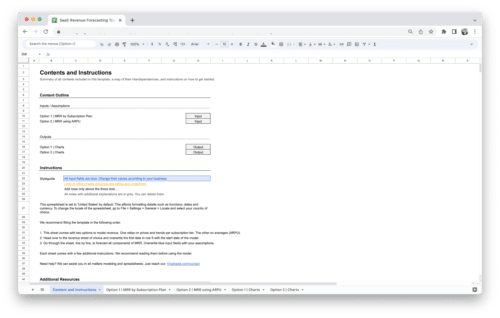
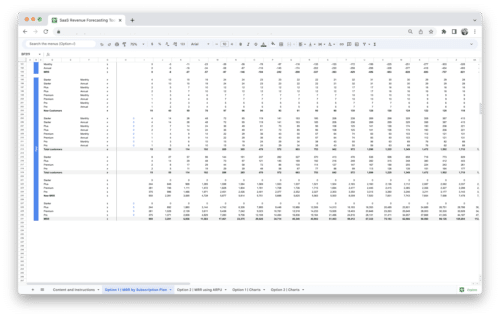
SaaS Revenue Forecasting Tool
41,18 €Value added tax is not collected, as small businesses according to §19 (1) UStG.
Add to cart Details -
Sale!


SaaS Profit and Loss Statement
100,00 €Original price was: 100,00 €.66,39 €Current price is: 66,39 €.Value added tax is not collected, as small businesses according to §19 (1) UStG.
Add to cart Details -
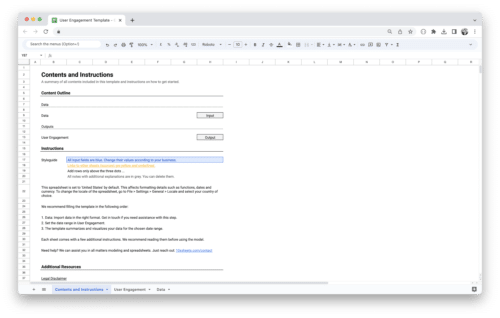
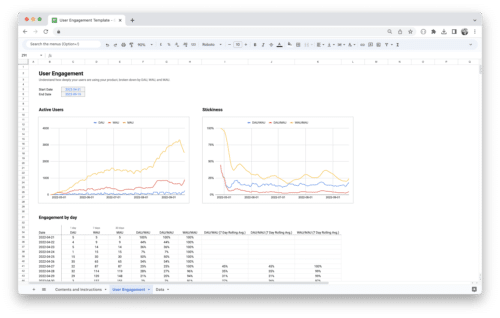
Value added tax is not collected, as small businesses according to §19 (1) UStG.
Add to cart Details -
Sale!


Standard Financial Model Template
184,03 €Original price was: 184,03 €.125,21 €Current price is: 125,21 €.Value added tax is not collected, as small businesses according to §19 (1) UStG.
Add to cart Details

